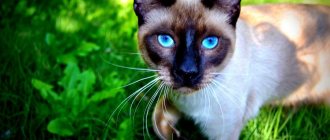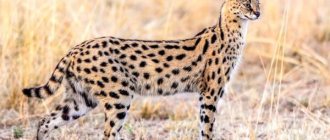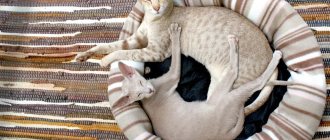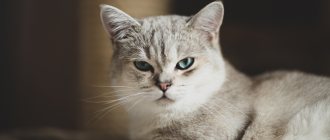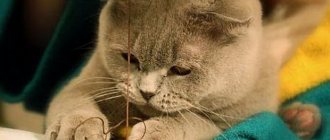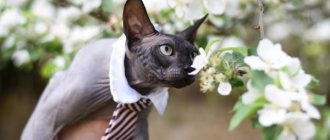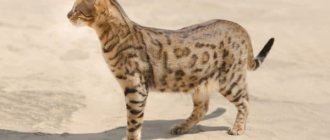The Siamese cat is a popular short-haired breed with a recognizable point color. Unique beauty is combined with sociability and intelligence. A good companion for those who value open expression of feelings and constant connection with their pet. These talkative cats will not let you get bored and will participate in all family activities.
| Breed | Siamese cat |
| Type | Siamese-oriental (eastern) group |
| Country of origin | Thailand |
| Coat | Shorthair |
| Lifespan | 15 – 25 years |
| Kitten price | 8000 – 35000 rubles |
History of the origin of the Siamese breed
The Siamese cat is one of the oldest and most famous cat breeds. Despite this, the origin of Siamese cats is still considered a mystery.
- The manuscript "Book Poems about Cats", dating back to 1350 - 1700, discovered in ancient Siam (modern Thailand), describes a pale cat with a dark coloration of the face, paws, ears and tail.
- According to legend, the Siamese were considered sacred. When a member of the royal family died, his soul was possessed by a Siamese cat, which then lived in the temple in luxury with monks and priests as servants. The theft and killing of a Siamese cat was punishable by death.
- Uncontrolled crossbreeding of Siamese in the 19th and 20th centuries led to cats no longer meeting the breed standard. Modern Siamese have become thinner and have acquired a characteristic triangular muzzle.
Subsequently, Siamese cats quickly became popular in different countries. This breed was first seen in Europe in 1871 at the London Cat Show. In 1879, a Siamese cat was given to the wife of the US President. The Siamese Cat Club was formed in 1901 in Great Britain, and the Cat Fanciers' Association (CFA) recognized the breed in 1906.
Related breeds:
- Oriental cat.
- The Balinese cat is a semi-longhaired Siamese cat.
- Burmanskaya.
- Thai is a restored Siamese breed according to the old type standard.
- The Himalayan is a long-haired breed developed by crossing Siamese and Persians.
Differences between Siamese and Thai breeds
Top cat breeds with green eyes
Often it is black and gray cats that have green eyes. Therefore, the list includes breeds whose representatives more often than others have a characteristic combination:
- Maine Coon. A blue-black coat is standard for this giant cat. And quite often, with such a “fur coat,” Maine Coons have rich green eyes. The same is true for smoky beauties. Despite their impressive size, Maine Coons are quite affectionate and gentle. They are often compared to dogs due to their high activity and developed intelligence.
- British cat. Among the representatives of this breed there are quite a few black and gray individuals. However, with this color, orange or hazel eyes are more typical for them. A Brit with green irises is a rarity. Therefore, the price for such a kitten will be appropriate.
- Oriental. The black green-eyed Oriental cat is a real panther in miniature. She is elegant, graceful and extremely agile. And the beauty of emerald eyes will be revealed thanks not only to their considerable size and expressive almond-shaped cut, but also to ebonite wool. The appearance of Orientals is in harmony with their character. They enjoy games and human attention. Potential owners should take into account that this is one of the most talkative breeds. Orientals love to “comment” on their actions in a loud, expressive voice.
- Bombay cat. Black fur and green eyes are the breed standard. Bombays are sensitive and gentle felines. The attention of the owner is extremely important for them: they cannot stand loneliness and prefer lying on the couch together to active games.
- Devon Rex. These elf cats are notable for their miniature size, curly hair and huge ears. Often black-and-silver, black-ash and black-blue Devons have green eyes. Their cute and funny appearance matches their personality: Devon Rexes are childishly playful and curious. They adore their owner and tirelessly demonstrate their devotion to him.
- American Bobtail. Their appearance also often combines black fur and green eyes. These are truly family cats who love all the people in the house, and not just one. They equally love games and quiet time.
- Japanese Bobtail. Unlike its American counterpart, the Japanese Bobtail is more graceful and petite. And coal-black representatives of the breed with green eyes are much more common. There are also differences in temperament. It is extremely important for Japanese Bobtails to be with their owner. In terms of their level of devotion, they are often compared to dogs.
- Turkish Angora cat. Oddly enough, black green-eyed angoras were previously an anomaly. Initially, these were exclusively white cats. However, the spectacular color attracted the attention of breeders, thanks to which today a charcoal beauty with green eyes is not uncommon. Turkish Angoras have a very compliant and affectionate disposition. But at the same time they are quite curious and playful. These cats are more suitable for people who are willing to give them a lot of attention.
- American Curl. This cat is notable for its dense, inside-out ears. However, breeders have not yet been able to achieve 100% purity of the breed: more than half of the kittens from the litter appear with a normal ear. There are some peculiarities in the coat color. Because the hairs are very short and tightly packed together, curls appear to be jet black. However, the standard color for them is dark chocolate along with rich yellow eyes. Green-eyed kittens are also found, but much less frequently. The character of curls is also unique. They are calm and unobtrusive, but they love children and are quite silent. More often they do not meow, but purr expressively.
- Norwegian forest cat. An extremely impressive breed due to its considerable size and extremely fluffy coat. Norwegians come in a variety of colors. And black, coupled with green eyes, is one of them. The character of these animals correlates with their appearance. They are gentle and patient and get along well with children and other pets. However, they will only be truly loyal to one person.
- Siberian cat. Like Norwegian forest cats, Siberians can come in a variety of colors. Black is one of them. But it is found in different variations: chinchilla, black tiger, marble, black smoke. For Siberians, the general rule is true: the blacker the coat, the greener the iris. These animals have a typical cat disposition: they can play, lie around, and keep themselves busy.
- Ragdoll. This breed has won universal love thanks to its gentle and flexible disposition. Although they owe part of their popularity to their remarkable appearance. Ragdolls are large cats with surprisingly soft fur. And although the breed standard does not include black color, Ragdolls are often born with dark chocolate or coffee coat and green eyes.
- Ragamuffin. This breed appeared as a result of crossing ragdolls with ordinary yard cats. Experts took this step to diversify the color and increase the immunity of the breed. Among ragamuffins there are black individuals with green eyes. Moreover, the standard indicates that the more saturated the shade, the better. Ragamuffins inherited their gentle disposition from Ragdolls, which is why they became more popular than their ancestors.
- Cornish Rex. According to the standard, Cornish dogs can have two colors: “black smoke” and “black coal”. With the first, the animal has light skin, with the second, the kitten is completely black, including the nose and paw pads. However, in both options the pet may have green eyes. Cornish Rexes are extremely mischievous and playful cats. It is important for them to be around people, so they are not suitable for those who prefer a passive lifestyle.
- Persian cat. Among Persians, black coloring combined with orange or copper eyes is quite common. Sometimes there are green-eyed individuals, but this is rather an exception to the rule, so the price for such a kitten will be higher. There are no Persians with a bright emerald iris, at most - with a marsh or gooseberry iris. It is noteworthy that the shorter the coat, the brighter the eyes. If you want to find a kitten with a rich iris, it is better to pay attention to smooth-haired representatives of the breed. Persians are calm cats who prefer to lie on the sofa next to their owner rather than play and run around the apartment.
- Laperm. These cats are related to the Rex, which explains some of the similarities in appearance. Laperms have fur that is curled in a spiral, so at first the cat appears to be wet. They can come in a variety of colors. Sometimes there are black green-eyed individuals. These are sociable and friendly cats. Many lapermas show interest in the human face: they like to touch it with their paws or climb on the shoulder to be closer to it.
- Manx cat. In appearance, Manx cats are very similar to the British, but they do not have a tail. Some believe this is a mutation, while others believe that Manxes are indigenous breeds that arose without human intervention. Be that as it may, among Manx cats there are cats with black fur and green eyes.
- Scottish fold cat. They are remarkable for their appearance. As a result of the mutation, they have ears curled forward, which makes their appearance cute and unforgettable. There are representatives of the breed with the classic ear: until now, breeders have not achieved one hundred percent purity of the subspecies. But in both variations there are black, green-eyed cats. The Scots do not have bright green eyes; the color of their eyes is close to dry grass or gooseberries.
- Sphinx. There are representatives of the breed with very short fur. It feels like velor to the touch. Sphynxes can have a black color in various variations: when only the fur or only the skin is black, and sometimes there are individuals with both skin and fur charcoal. Similar colors are included in the standard. Of course, such kittens have green eyes.
- Burmilla. This is the result of crossing a lilac Burmese cat and a chinchilla Persian cat. Representatives of the breed can be of different colors: from gray-silver to charcoal black. Often even light-colored Burmillas have green eyes. True, the darker the wool, the richer and greener the iris.
- Mandalay. A relatively young breed, related to the Burmese. According to the standard, mandalayas can only be black, with slight variations from coffee to charcoal. This increases the chance of finding a kitten with green eyes. Although more often representatives of the breed have yellow, orange or green-yellow irises. Thanks to the admixture of simple yard cats, Mandalays have excellent health and a strong nervous system. They love to play and communicate, and also easily get along with children.
- Munchkin. The cat is a bit unusual in appearance, as it has very short legs despite a standard body. For munchkins, black color and green eyes are not uncommon, although yellow or orange irises are more typical for dark coats.
- Russian blue cat. She is quite elegant and aristocratic. The coat of this breed is pearly gray and velvety to the touch. According to the standard, these animals can only have green eyes. Blue and yellow are considered defective. The character of the beauties matches their appearance: they are calm and very affectionate with their owners.
- Nibelung. This breed is a long-haired version of the Russian Blue cat. Like its closest relative, the Nibelung has pearl-gray fur. But the eye color can be not only rich green, but also amber-yellow. The character also has common traits. Nibelungs are quite friendly, affectionate and love active games.
- Korat. In color, Korats resemble Russian Blue cats. They also have silver fur and piercing green eyes. The standard does not provide otherwise. But there are differences in body type. The Korat is a Thai breed, so the animal has some elongation, characteristic of many Asian cats.
Maine Coon - cat with green eyes
British cat with green eyes
Green-eyed oriental cat
Bombay cat with green eyes
Green-eyed Devon Rex
American Bobtail – cat with green eyes
Cat with green gases - Turkish Angora
American Curl with green eyes
Green-eyed Norwegian cat
Siberian cat
Ragdoll cat with green eyes
Green-eyed cat - ragamuffin
Green-eyed Cornish Rex
Persian cat with green eyes
Cat with green eyes - laperm
Manx green-eyed cat
Scottish Fold - a cat with green eyes
Sphinx with green eyes
Burmilla - a cat with green eyes
Mandalay - a cat with green eyes
Green-eyed munchkin
Russian Blue – cat with green eyes
Nibelung - a cat with green eyes
Korat - green-eyed cat
Not only black and gray cats can boast of beautiful green eyes:
- Singapore cat. This miniature breed is native to Southeast Asia. It has a very unusual color - “sepia agouti”. The fur on the body is a rich shade of ivory, which turns dark brown when moving. The reason is the so-called “ticking” - a phenomenon when hair goes from light at the base to dark at the tip. Most often, Singaporeans have yellow eyes. However, there are also individuals with a bright emerald iris.
- Abyssinian cat. This is one of the oldest breeds in Egypt. Abyssinians are notable for their graceful elongated physique, beautiful rich red “fur coat” and large almond-shaped emerald-colored eyes. These cats are active and playful in nature and appreciate human attention. They should not be acquired by passive and phlegmatic people.
- Somali cat. The Somali is a relative of the Abyssinian cat. Many even consider it a long-haired variety, and not an independent breed. Red-haired Somalis often have beautiful green eyes.
Singapura cat
Abyssinian cat
Somali cat
Regardless of the breed, cats of some colors also have a rich green iris.
This is primarily typical for chinchilla cats. With this color, the animal’s fur is rich white and only at the very tips turns into contrast. Moreover, transitional hairs can only be on the head, ears, back, sides and tail.
Small marks may be found on the cheeks and paws. And the chest, belly and inner sides of the limbs should remain snow-white. This color is often found in Persians, exotics, British cats, fold cats and Burmese cats.
Important! Chinchilla cats can have aquamarine and blue-green eyes. It is quite difficult to predict in advance what a kitten’s pupils will be like. For those who are looking for emerald eyes, it is better to adopt a teenage cat or choose a breed for which only green irises are prescribed by the standard.
Another potential owner of emerald eyes are silver tabby animals. The well-known cat from the Whiskas advertisement had this coat color. Therefore, the silver tabby is often called “whiskas” or “whiskas color”. It is most often found in British, Scottish, American Shorthair and ordinary yard cats. However, with this color, a cat can have not only green, but also yellow eyes.
Description of the Siamese breed
Let's look at the appearance and character of Siamese according to the breed standard.
Standard
Siamese cats are well balanced, boasting an athletic, flexible body and elegant, slender legs.
The breed standard for the modern Siamese cat assumes:
- Body: Elongated, tubular and muscular. A typical Siamese cat has a total height of 20-25 cm and a body length of 29-36 cm, with a body weight of 4-5 kg.
- Head: Straight profile with a strong chin and a pleasant, even bite. The head forms a perfect triangle from the tip of the nose to each tip of the ear. The neck is long. The eyes are almond-shaped, bright blue, and the ears are large, wide, located closer to the head.
- Limbs: The cat's hind legs are longer than her front legs, which adds to her athletic and graceful appearance. The paws are oval shaped and small. Thin tail.
- Coat: Short, shiny, fine coat without undercoat that lies close to the body.
Today, there are over 20 varieties of Siamese cat colors all over the world, and the most famous of them are:
- Seal point (brown or cream), with a cream-colored body and dark brown pigments on the nose and paws. It is believed that this was the original color of the breed when it was first exported from Siam (Thailand).
- Blue Point (blue) - the body is snow-white with a bluish tint, as well as a gray nose and paws.
- The Red Point is a white body with red (apricot) pigments on the nose and paws.
- The Caramel Point (light cream) is considered a hybrid due to a complex breeding process, with very light and pink pigments on the nose and paws.
- Chocolate point (black). The body is cream or milky in color, and the pigments on the points can range from chocolate to black.
- Cinnamon point (ivory). The body is ivory-colored, like a Chocolate Point, but the markings on the nose and paws are pinkish-brown.
Photos of colors
Seal Point
Blue Point
Red tabby point
Caramel point
Chocolate Point
Cinnamon Point
Advantages and disadvantages
Siamese have a lot of advantages and disadvantages:
| pros | Minuses |
|
|
Before purchasing a pet, it is advisable to determine whether the animal is suitable in temperament and habits.
Character of Siamese
Siamese are known for being one of the most intelligent and vocal cats in the world and will happily spend time with their owners. Siamese cats are affectionate with domestic cats, however, they can be demanding and suspicious of strangers. Many people say that their Siamese pets greet strangers at the door and go through some kind of approval process before visitors enter the house.
At the same time, Siamese cats are very active and love active games with toys. When it comes to training, they do not have any special exercise needs because Siamese cats are very active and playful in their own right.
They quickly get accustomed to the litter box and scratching post; the main thing is not to shout or force the cat to do anything. Siamese are quite proud and can become stubborn from such treatment. You can even toilet train them if you start training them when they are young.
You should not get a Siamese cat if you are often away from home. The pet will get bored and entertain itself in any of the available ways.
The stereotype about the evil character and vindictiveness of the Siamese, as a distinctive feature of the breed, originated in the USSR. The price of a purebred Siamese cat was high, so we usually received rejected kittens with squints, creases in the tail and abnormalities.
Why are kittens born with green eyes?
The color of a cat's iris depends on its base color. There are quite a lot of cats with unexpressed green eyes. But finding an individual with a bright emerald hue is difficult. Often the intensity of eye color depends on the intensity of the color. That's why black cats have a very rich iris color.
Interesting! Previously, green eyes were very common in cats. However, breeders have become interested in breeding kittens with unusual iris colors to such an extent that green pupils are now a rarity.
Bright green eyes are the most difficult to predict. The color of a kitten's iris depends on the amount of coloring pigment in both the back and front of the eyeball.
All kittens have blue eyes at birth, and at 3–6 months the iris is completely recolored to its final color. This is explained by the fact that the embryo has a lot of melanin. And it is distributed in such a way that when light is reflected, the eyes appear blue.
If the front of the apple becomes more pigmented as the cat gets older, the eyes will turn yellow. If the back color is blue, it seems to “shine through” through the front yellow, and as a result, the cat’s eyes appear green.
Thus, to produce a deep green color, the pigment in the back of the eye must predominate over the amount of pigment in the front. If this prevalence is excessive, the eyeball will turn turquoise.
Another interesting phenomenon is when the pigment in the middle of the eye has a medium intensity. In this case, the cat will have a green-beige or malachite iris.
Interesting! Variations in the combination of pigments can be very different, so a cat may well become the owner of extremely unusual eyes. Often, even professionals find it difficult to determine the color of an animal’s iris. In this regard, in the description you can find such definitions as “khaki”, “peas”, “bright pine” or even “burnt grass”.
Health
With proper care and nutrition, the average lifespan of Siamese cats is 15-25 years.
They may also have problems with progressive retinal atrophy, which can lead to poor vision and even blindness. Glaucoma and strabismus are also common among eye diseases.
This breed is more prone to lung infections than others. The most common condition is asthma, which causes inflammation and narrowing of the lungs' airways.
These cats are known to have very sensitive stomachs. In addition, Siamese cats may have problems with the heart, kidneys and liver.
Advantages and disadvantages of the breed
The positive characteristics of Siamese cats include:
- Magnificent mind.
- Excellent trainability.
- Loyal to their master.
- They have an attractive appearance. This can be seen by looking at a photo of a Siamese cat.
- They get along well with the smallest members of the family.
- Practically not subject to shedding.
- Playful and cheerful.
Pets also have disadvantages:
- Siamese are very touchy and can remember bad things for a long time.
- They are independent and have willful characteristics.
- Demanding about cleanliness.
- They do not tolerate cold well.
- They have a fairly loud voice.
- They are jealous and cannot tolerate cohabitation with other animals.
Breed card
| Characteristics of a cat | Notes | |
| General information | An ancient cat breed known for its pointing color, playfulness and ringing voice. Extroverts by nature | Modern Siamese are the result of restoring the standard of an ancient breed. And those yard cats, which in Russia are usually mistaken for Siamese, are representatives of the Thai breed |
| Character | Siamese require their owner's attention constantly. They have an affectionate nature and are quick-witted, but can be stubborn | Purchase various toys in advance so that your pet always has something to occupy himself with. The best solution would be to purchase a play set for cats |
| Appearance | A medium-sized cat with a slender, athletic body, an elongated wedge-shaped head, large ears, and blue or blue eyes. Kittens are born completely white. Points (areas of dark fur) develop as the dog matures, with the sides usually being the last to darken. The final color is formed by 2 years of age. | Strabismus and creases in the tail are a defect in the breed. If you are offered a kitten with green or yellow eyes, then this is not a Siamese, but perhaps an Oriental. |
| Behavior at home | Active breed. They love to climb and play. Very talkative, especially cats during mating season | Siamese are sexually horny cats, so their puberty begins earlier than other breeds. You can castrate your pet at the age of 4-5 months. |
| Care | Minimal maintenance as there is no undercoat. Combing once a week. A scratching post is required | |
| Health problems | Among the congenital defects there is strabismus. Modern Siamese have problems with tail kinks and respiratory problems | Food allergies to cow's milk are common |
Pregnancy and childbirth
Cats typically reach puberty at 8 months of age. But Siamese cats, which belong to the oriental type, enter this period earlier - at 4 - 5 months. The onset of sexual activity may be influenced by the time of birth of the animal. A woman born in the spring may demand a cat in the fall, and a woman born a little later will most likely begin to come into heat in the spring of next year. The ability to reproduce begins only at 10 months of age and continues until 8 years.
The average gestation period for Siamese cats is 65 days. Lambing that occurs before 60 days is considered premature. Kittens born at this time are considered non-viable. If labor does not begin on day 68, we can talk about post-term kittens, in which case you need to seek help from a veterinarian.
If the date of the tailed couple was successful, then in the first month the first changes in the appearance and behavior of the cat will become visible. At this time, there is a slight increase in weight. There may be loss of appetite and slight vomiting. After day 35, the cat’s tummy becomes rounded, the nipples turn pink and enlarge. There is an appetite and a desire to sleep longer. During this period, the cat’s life is almost no different from before, but too active games should be prohibited, although dosed activity is necessary. In the later stages, a pear-shaped tummy appears, and by placing your hand on it you can feel the kittens moving. 2 weeks before birth, the movements of the kittens in the womb are clearly visible when the tailed mother lies on her side. During this period, the animal's activity is significantly reduced. It is best to provide your cat with a cozy place to rest and not disturb her unnecessarily.
During pregnancy, the cat should feel comfortable
A week before the start of labor, take your pet to the veterinarian and agree with him so that qualified assistance is immediately provided in case of complications.
The behavior of the animal speaks eloquently about the approach of childbirth. The cat begins to actively look for a place to lamb. The loop enlarges greatly, and clear or light pink discharge appears. The tailed mother may completely refuse to eat. The animal becomes especially affectionate and demands attention to itself.
For lambing you need to prepare a special place, or better yet several. Any cardboard box with low sides will do so that the cat does not touch her stomach. The box is lined with a warm mattress or a blanket folded several times, over which a clean sheet (disposable or cotton) is laid. The nest is placed in a secluded place where households or pets do not look.
A naturally physically developed and healthy cat will cope with childbirth on its own. But your presence nearby is simply necessary, especially if the cat gives birth for the first time. Just be nearby so that the furry woman in labor feels your presence and support.
Just in case, prepare the necessary tools to assist the tailed woman in labor and her offspring. You will need:
- sterile gloves;
- sterile scissors with rounded tips;
- thread for tying the umbilical cord (catgut);
- clean diapers and towels for drying kittens;
- eye pipette for suctioning mucus from the respiratory tract of kittens;
- iodine;
- peroxide;
- cotton buds.
Keep your phone number and veterinarian number nearby in case you urgently need advice or help.
Once the kittens are born, you will need to monitor the temperature inside the nest. To do this, place a thermometer at the bottom of the box. During the first 3 days of life, kittens need to be warm, so keep the temperature around 29°C. This can be easily done by placing a heating pad under the mattress. Then, every week, reduce the temperature by 3°C, gradually bringing it to 21°C.
Newborn Siamese kittens - video
Care
They are incredibly clean and don't shed much, so caring for them is not particularly difficult.
Wool
Even though Siamese cats have short hair, they need to be brushed weekly. Many fans of this breed recommend small rubber brushes. You need to comb in the direction of hair growth.
Most Siamese cats are very clean and clean themselves well, so you can bathe them no more than 2 times a year. However, when they are very dirty or have gotten into something sticky, they may need a little help.
Advice! Place a rubber mat in the sink or bathtub to prevent your cat from slipping.
Nutrition
In addition to basic veterinary care such as vaccination compliance and regular checkups, proper nutrition is important. Providing a proper diet can help prevent health problems in your pet later in life.
Advice! Don't forget to change the water and wash the bowls daily!
There are two options for feeding your pet: natural food and industrial food.
Natural nutrition
- Basic nutrition – animal proteins:
- Lean meats (chicken, rabbit, lean beef and turkey).
- Sea fish and seafood (tuna, cod, shrimp) - as a source of healthy fats and taurine.
- Eggs (preferably quail) – no more than once a week.
- Beef liver and offal - tripe, udder, lips, chicken necks.
- Carbohydrates and fats
:- Fermented milk products - cottage cheese, ryazhenka kefir, yogurt without additives.
- Vegetables and greens - zucchini, carrots, spinach, pumpkin, broccoli, peas, beets.
- Porridge – buckwheat, millet, oatmeal, rice.
- Linseed oil.
- Vitamins – additional vitamin complexes are required for natural nutrition. Main additives: taurine, tetravit, calcium and yeast as a source of B vitamins.
Important! Red meat and liver can darken light fur, so you should not make such foods the main food for show cats.
Industrial feed
The basic rule is not to feed your pet economy-class food. The ideal option would be brands from the super-premium and holistic categories. We have previously compiled ratings for dry and wet cat food.
Recommended brands:
- Orijien Fit & Trim.
- Acana Light & Breed.
- Go Natural.
- Eukanuba Sterilized.
- Bosch Sanabelle.
- Royal Canin “Sterilized 37”.
Sometimes cats are allergic to grains, cow's milk and poultry. In such cases, it is necessary to switch to grain-free lines such as Natural & Delicious, which are free of rice, corn and chicken.
Adult pets with certain diseases (diabetes, urolithiasis, renal failure and heart pathologies) are transferred to specialized veterinary nutrition. A good line of medicinal foods is represented by the Hill's Prescription Diet brand.
Vitamin-mineral complexes are not needed, because manufacturers necessarily include all the compounds necessary for the body in the feed.
Caring for ears, eyes, teeth and claws
- If possible, you should brush your cat's teeth 2 times a week. We revealed all the nuances of this simple procedure in this article.
- The almond shape of the eyes allows pus and tear fluid to accumulate in the corners, so be sure to wipe your eyes with a damp cotton pad as needed.
- Ears should be wiped with a barely damp cotton pad once a week. If you notice black spots, crusts and an unpleasant odor, take your pet to the doctor. The most common cause of such symptoms is ear mites, which are easily eliminated in the initial stages. If left untreated, it can lead to hearing loss.
A visit to the veterinarian every year is mandatory for keeping a Siamese cat. Examinations provide an opportunity to early detect health problems, including those that may change your cat's care needs. For example, viral diseases, eating disorders, heart and kidney problems.
The frequency of visits to the veterinarian depends on the age of the pet:
- kitten 1-4 months – monthly visits;
- 4 months to 7 years – 1-2 times a year;
- 7-10 years – twice a year;
- over 10 years old - visit every 3 months or more often, as age-related health problems only increase.
Walking your pet
Siamese cats are ideal pets for both apartments and country houses. They are perfectly adapted to travel and trips, because the main thing for these creatures is the presence of their beloved owner nearby. Cats are good travel companions when they are happy. Your job is to figure out how to make their journey comfortable. Bring your favorite bed, litter box, toys, food and litter box.
They can also be easily trained to walk outside in a harness or in a walking carrier.
How much money do you need for care and maintenance?
What to buy for a kitten
Required set:
- Two or three bowls (depending on the type of feeding). Choose a large water bowl - Siamese often like to drink from large containers. Price: 150 – 320 rub.
- Tray. Large with deep sides: 250 – 1350 rub.
- Wide-toothed comb or brush with natural bristles: RUB 350 – 650.
- Scratching post: 900 – 2500 rub.
- Toys. Choose intellectual ones and those that you can run after. Price: 600 – 3500 rub.
- Plastic carrier with metal door. Price: 1250 – 2600 rub.
- Bed. Warm with sides: 500 – 2000 rubles.
Additional products:
- Vertical game complex. Price: 5000 – 32000 rub.
- Claw cutter. Price: 350 – 590 rub.
- Harness with leash. Price: 850 – 1600 rub.
- Anti-cat bars for windows. Price: 1800-2450 rub.
- Automatic drinking fountain. Some Siamese cats love to drink running water. Price: 1800 – 4800 rub.
The annual care of a Siamese cat may require from 20 to 40 thousand rubles.
The budget will depend on your capabilities, the chosen diet, the type of filler and the health of the pet.
How to choose a kitten
When choosing a Siamese kitten, the most important things are its health and pedigree. Therefore, it is imperative to see the kittens’ parents and find out about their general health. Any mention of heart or liver problems in either parent should be noted as these can be passed on to the kittens.
You should also look at the place where the kittens are kept to make sure that they are free of dirt, fleas and ticks. Siamese kittens are social and quite dependent on their parents.
Therefore, kittens should not be weaned from their mother before 12 weeks of age, otherwise they may develop severe anxiety disorders.
You may notice that the kittens are either creamy white or lighter in color than expected. This is fine. The face, paws and tail darken at about 4 weeks of age and continue to darken until the kittens are 1-2 years old. The size of the points directly depends on the temperature of the habitat. The lower the temperature, the more the coat darkens.
That's why newborn kittens, warm from their mother's womb, are white everywhere. Then, as they grow at normal temperatures, the hottest area of their body, around the belly and back area, remains pale while the limbs gradually become darker. And in an adult cat, the general body temperature begins to drop somewhat, and over time the fur darkens more and more.
As for the cost of a kitten , this indicator depends on the following factors: age, pedigree, health status, availability of vaccinations, travel box, toys, etc. Also of great importance is the owner's guarantee that her parents do not suffer from any serious diseases that could be inherited by the kitten.
- The price of a pet-class kitten (pet) is 3000-8000 rubles.
- Breeding class (breeding) – 10,000-15,000 rubles.
- Show class (show kittens) – the price depends on the nursery, from 30,000 rubles and above.
How much does a Siamese kitten cost?
The average price for a Siamese kitten is 8,000 – 35,000 rubles (5,000 – 10,000 UAH).
What does the price depend on?
Price formation is influenced by:
- kitten class;
- floor;
- colors;
- age;
- prestige of the nursery;
- parents' titles;
- sale with or without breeding rights;
- pedigree.
The biggest influence on the cost is belonging to a certain class:
- SHOW (show) – kittens are sold with the right to breed and are allowed to participate in exhibitions and competitions. Price: from 25,000 to 45,000 rubles;
- BREED - healthy kittens without genetic pathologies and good characteristics, have minor deviations from the standard, can be exhibited and allowed for breeding. They cost from 10,000 to 15,000 rubles.
- PET (pet) - pets without the right to breed, are not allowed to exhibitions. Price: from 3,000 to 10,000 rubles.
Breeding
If you decide to start breeding a Siamese cat, the first step is to find a healthy male. Of course, the best way to do this is to contact the owner of a nursery near where you live. A Siamese cat owner with a good pedigree will be happy to help you in this matter, as he knows how important it is to keep the blood lines pure and reduce the risk of any hereditary problems.
When choosing a breeding cat for your Siamese breed, consider the following factors:
- Is this the first time your female will be mating? If the answer to this question is yes, then you should think about having an experienced male.
- Have you had all the necessary tests? Before you take your cat for mating, you should arrange a visit to the veterinarian to confirm the absence of hereditary and viral diseases.
- What are you going to do with the kittens? When choosing a breeding cat, you need to make sure that you can sell the kittens in the future.
Pregnancy in Siamese cats is slightly shorter than other breeds - 58-65 days. On average, a Siamese cat gives birth to 4 to 6 kittens. The colors of kittens can be predicted in advance by knowing the recessive and dominant genes for coat colors in both partners.
Siamese catteries in Russia
The Siamese breed is one of the most numerous, so finding a nursery is not difficult at all:
- "Orientville" - Moscow.
- "Siaorimania" - Moscow.
- "Jubatus" - Novocheboksarsk.
- "JUNGLE" - Moscow.
- "Eastward" - Moscow region.
- "EkstaSia" - Yekaterinburg.
Taking the kitten home
If you have already found a suitable cat with kittens, you should take into account that premature deprivation of babies from maternal care has a bad effect on their psychological state. So, in this regard, we can strongly advise you not to adopt a kitten until it reaches one and a half months old. The best thing to do would be to wait even longer.
Fluffy babies of any breed, of course, do not easily tolerate a change in their usual environment. So, if a kitten in a new place immediately climbs into some distant secluded corner, where no one can get it, then this is quite normal.
And then you should not try to call it out, but you should place bowls with drinking water and food nearby, as well as cat litter.
Try not to make loud and sharp sounds at first, so that the baby does not get scared and realizes that the environment around him is completely safe with non-hostile inhabitants. After some time, usually an hour or two, the kitten’s curiosity and hunger will prevail, and it will leave its shelter.
Interesting facts about the Siamese cat
- The color of their coat is determined not only by heredity. This breed has a special modifier gene that prevents the development of pigment in the fur, which leads to albinism.
- Siamese are considered one of the oldest cat breeds in the world.
- Legends say that in ancient times the first Siamese cats were tasked with guarding the royal cup. They looked at him with such intensity that their eyes crossed. For added security, the cats wrapped their tails around the cup, causing them to become permanently bent.
- Siamese cats have appeared in many Hollywood films.
Overall, this is the most affectionate cat breed you will find. She is very smart, obedient and friendly, and also loves and values human communication so much that she is even called a cat-dog.
Features of caring for cats with green eyes
Potential owners should understand that caring for a cat does not depend on the color of its eyes. Caring for your pet should be based on its needs and the characteristics of the breed. The breeder from whom the kitten is being purchased will tell you in more detail about this.
Rich green eyes are a true decoration of any cat. This color can be found among representatives of different breeds. Those who want to buy a kitten with such an advantageous appearance just need to choose an animal that will suit their character and lifestyle.
Siamese - movie star cats
In old but interesting American movies such as The Incredible Journey, Lady and the Tramp and That Damn Cat! Siamese cats starred. In fact, the entire plot of "Cursed Cat!" The story centers on a Siamese cat named DC (or Darn Cat) who helps stop a kidnapping.
The Thaicat website has more information about Siamese cats in movies
While DC is out of this damn cat! helped prevent a fictitious kidnapping, two real Siamese cats helped prevent espionage back in the 1960s.
When two Siamese kittens living in the Dutch embassy in Moscow began scratching the wall, their owner suspected they were responding to noise that could not be detected by the human ear. He was right - 30 small microphones were found behind the wall.
